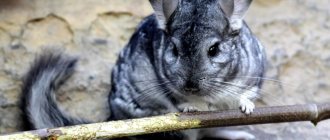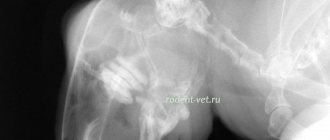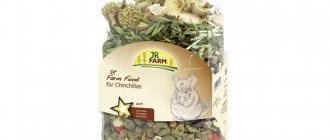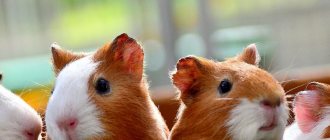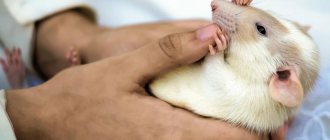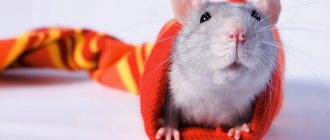Like many other rodents, all types of chinchillas have teeth that grow continuously throughout the pet's life. In the wild, this does not bother them in any way, since animals wear out their teeth by chewing hard food, tree bark, etc. But if a chinchilla is kept at home, it is important to provide the animal with suitable conditions, otherwise the chinchilla’s teeth will grow for a long time and cause serious health problems in the pet. pet. If they are already grown, you may need to take your chinchilla to the vet to have them trimmed. The doctor must be properly licensed to provide veterinary services for exotic animals.
chinchilla teeth
Number of teeth and their structure
How to look at a chinchilla's teeth if this is your first pet of this species? The first time it’s quite difficult, because visually you can only see the pet’s front teeth, and only if you move the upper lip? Experienced breeders know how many teeth a chinchilla has – there are 20 of them:
- at the top and bottom there are 2 incisors - 4 in total (depending on the size of the individual - from 6 to 12 mm long);
- The 16 other teeth are 4 premolars on both gums, two each, and 12 molars on the sides of them.
The chewing teeth of this rodent have a ribbed and wide surface. They are located deep in the gums - the total length of the tooth reaches 12 mm (9 mm - root, 3 mm - crown). These animals have no fangs - the space between the incisors and molars is called “diastema”.
Inexperienced owners often wonder why chinchillas have yellow teeth? This is fine. The front row of a healthy adult chinchilla is always dark yellow or even orange. The fact is that the back of a chinchilla’s teeth is not covered with enamel, so they quickly wear off and become stained the color of the food they eat, for example, carrots. But the cubs are initially born with white incisors.
Newborn babies have 4 incisors and only 8 molars.
Mashusha
The structure of teeth in chinchillas. Malocclusion (hooks).
Teeth play one of the most important roles in life. With the help of teeth, animals capture, hold and chew food, hunt for prey, defend themselves, build their homes, and much more. In order to learn about some dental diseases, you must first consider their structure.
Let's look at the structure of a tooth using a human example:
It is easy to write the dental set in the form of a formula. The formula is compiled only for one side of the upper and lower jaws (to calculate the total number of teeth, you must multiply by 2). Designations: I - incisors, C - canines, P - premolars and M - molars, upper and lower jaws - numerator and denominator of the fraction.
Chinchilla teeth set:
The structure of the chewing surface and the number of molars are important characteristics that are used to divide rodents into different families, subfamilies and genera, as well as in the diagnosis of species.
X-ray. Spikes on the upper molars, the lower first incisor is angled and directed forward.
Inspection of bedrock swells is carried out using an otoscope. If hooks are found, they are trimmed. If the chinchilla is calm, then the entire procedure is carried out without the use of general anesthesia. Unfortunately, the disease is not curable. Chinchillas with malocclusion are removed from breeding due to the fact that this disease can be transmitted hereditarily. You can only prolong the life of your pet by feeding it artificially, constantly taking it to the veterinarian for examination and carrying out procedures to remove hooks. But unfortunately, the result is the same. for some in a month, for others in a few years.
There have been cases of plaque and tartar detection. Plaque
- biofilm located throughout the oral cavity.
It consists of mucus and more than 300 types of bacteria. Tartar
is an acquired formation at the site of dental plaque, which occurs due to mineralization (a mixture of phosphate and calcium carbonate with a small content of organic substances and various microorganisms). Bacteria, together with pieces of stuck food, form a soft, light-colored plaque. Then calcareous salts contained in saliva settle on the plaque, and it acquires a dense consistency and becomes tartar. Over time, tartar darkens, grows and increases in volume. As a rule, tartar forms on the front and back surfaces of the tooth, i.e. places with weak mechanical load. Inflammation of the gums and drooling occurs. The stone is removed by a veterinarian and anti-inflammatory ointments are prescribed. It is extremely rare.
Source
Causes of dental diseases
The first indicator that a pet has dental problems is refusal to eat. The reason may be that the fangs have grown too long, and the animal is simply uncomfortable eating. This immediately affects the pet’s weight. Owners should know how to grind a chinchilla's teeth - the animal should be comfortable eating at home. Trimming the fangs at home is not recommended; you should take the animal to the veterinarian.
In artificially bred chinchillas, dental disease factors can be:
- anomalies due to artificial breeding;
- lack of solid food (do not forget - the pet is a rodent);
- injuries to the jaws, due to which the teeth are displaced;
- diseases of internal organs due to artificial selection, which affects the quality of bone tissue;
- lack of calcium (minerals) in food.
If a female has produced offspring with such abnormalities, professional breeders do not allow these individuals to reproduce.
Crown regrowth
The second common dental pathology is crown regrowth.
When eating solid food or special objects, the rodent's teeth are ground down. If the animal does not have this opportunity, then the crowns of the teeth grow back, which causes other problems, such as malocclusion, excessive salivation, and subsequent refusal to eat.
Types of dental diseases in chinchillas
The chinchilla's jaw is designed in such a way that at the initial stage, dental problems can go unnoticed. Pathology appears already when the disease is advanced. And this is dangerous, since the animal begins to experience dysfunction of the digestive tract and liver.
For example, if a chinchilla has lost a lower tooth, and the owner did not notice it in time, then he can determine the problem by the wet fur around the mouth and on the chin. In this situation, you should immediately contact a veterinarian and determine why this is happening? This should not be the case for animals; they are adapted to eat carefully by nature itself.
Dental pathologies in chinchillas are different.
Signs of dental disorder
All chinchillas that suffer from a dental disorder will have obvious signs that can help diagnose the disease:
- wet and watery eyes,
- paw in mouth
- disinterest gnawing,
- crumbs remain after eating food granules,
- less hay consumption,
- squealing while eating
- decreased food intake and weight loss,
- difficulty drinking from a water bottle,
- frequent teeth grinding,
- bulges under the eye socket and jaw bone (bad bite).
In some chinchillas, a single tooth causes problems, even if all the other teeth are properly worn. In such cases, it may be necessary to have the problem tooth removed by a veterinarian.
Prevention of overgrown teeth
All types of artificial tooth extraction, as well as the introduction of anesthesia, are associated with certain risks and are stressful for the chinchilla. Therefore, preventing overgrown teeth is much better than treating them.
To do this, you should know a few important points:
- Some chinchillas become reluctant to chew anything hard if they have soft food that can be eaten without much effort. In this case, you will have to switch the animal to harder chewable food.
- In addition to food, hay or small tree branches that a chinchilla likes to chew on, teeth can also wear down. You need to determine what types of trees your chinchilla prefers to chew on and add them to the cage. You can try apple branches, poplar, willow, and aspen. Citrus, cedar and evergreen trees should be avoided.
- Wooden chew toys made from untreated wood are available at well-stocked pet stores. You should look for them in the section of products for rodents. A chinchilla's teeth can be slowly ground down with the help of chewing toys intended for parrots, as well as manzanita branches intended for poultry.
- Some chinchillas enjoy chewing pumice and mineral blocks. This, of course, wears down the teeth quite quickly.
- Check your pet's teeth regularly to spot signs of a problem as early as possible.
If the teeth are not treated, the chinchilla may get sick or even die. In critical situations, when an extreme measure is required - tooth extraction, it is necessary to monitor the remaining dentition even more carefully. If a chinchilla has had severe trauma to the mouth due to a blow or fall, the tooth that absorbed most of the impact may be destroyed due to nerve damage. The only way to prevent tooth loss is an appropriate diet during fetal development and throughout the chinchilla's life. To avoid injury to the animal, it is important to arrange the animal’s home, making it safe. The most important thing in this case is to completely eliminate the possibility of the chinchilla falling from a height onto a hard floor surface.
Malocclusion in chinchillas
These are the so-called hooks on teeth. They arise as a result of an incorrectly formed bite, which, in conditions of captivity, occurs due to insufficient erasure. The bite is affected by:
- poor nutrition;
- metabolic disease;
- lack of minerals in food;
- jaw injuries;
- genetic disorder due to long-term home breeding.
The first “bells” are a refusal to eat and rapid weight loss. The animal simply sorts through the food with its paws, but does not eat, and selects smaller and softer pieces from the feeder.
Further development of the disease is characterized by mouth movements and tearing. In animals everything is the same as in a person if he is sick: a lot of salivation, soft stools, ulcers on the gums. Pets stop eating because the tongue is constantly injured by the sharp edges of the dilapidated bone of the teeth, it just hurts them. After all, the animal often simply has nowhere and nothing to grind off its fangs. If you do not consult a doctor in a timely manner, the chinchilla will completely refuse to eat.
The solution is to trim the teeth. After it, you will need to feed the animal vegetable puree or boiled grain porridge for a couple of days. Feeding option - feeding puree with a syringe without a needle. Then the chinchilla will understand that there is no discomfort when eating, and will begin to eat on its own again.
If your chinchilla has a cold
If your chinchilla has a cold
The owner of a chinchilla may encounter some diseases of his pet. Most often, animals get sick due to improper care and nutrition. But sometimes colds also happen.
Colds in chinchillas occur at elevated body temperatures. Normal body temperature for a chinchilla is from 36 to 37.8°C, and an increase to 38 is already dangerous for this small animal; 39°C already poses a real threat to its life
To measure a chinchilla's body temperature, you need to lubricate the thermometer with Vaseline and very carefully insert it into the rectum 2-3 cm, try to hold the thermometer for 5 minutes. A chinchilla with a cold may sneeze and will likely develop a fairly severe runny nose.
Colds caused by high humidity, cold and drafts are dangerous for chinchilla babies and weakened adults. If a cold is not treated promptly, it develops into a serious and difficult to treat disease. In this case, the sick animal may die.
The most serious complication of a cold is bronchopneumonia. Symptoms of bronchopneumonia: rapid breathing, persistent cough, breathing becomes hoarse and heavy. Dried crusts form in the nasal passages, which interferes with the animal’s normal breathing. The nose may secrete mucus, the chinchilla often sneezes and rubs its nose and mouth with its paws. Behavior becomes nervous and unpredictable. The general condition of the animal is depressed, the pet becomes lethargic and drowsy. With such symptoms, it is necessary to take emergency measures, since there may be little time for a successful cure.
When the first symptoms of a cold appear, you should create the most comfortable existence for the chinchilla, because a sick animal with a cold needs special care. It is necessary to exclude drafts, additionally insulate the nest, remove dust and improve the quality of food. It is necessary to monitor the temperature and humidity in the room so as not to worsen the animal’s condition with dry and cold air.
Ingrown tooth roots
Elongation of the tooth roots in chinchillas leads to ingrowth into both gums. This can cause pathologies of the eyes and nose. You can notice changes by swelling on the muzzle in the area of the jaws. And lengthening the roots of the teeth on the upper jaw causes the eyes to bulge. Indirect signs:
- pain when you stroke the animal's head;
- refusal to eat;
- sudden weight loss;
- manifestations of conjunctivitis (excessively accumulating secretion in the corners of the eyes).
Ingrown roots rarely occur, but if this happens, it cannot be treated in chinchillas.
Biting or biting
Chinchilla biting is accompanied by other signs of aggression:
- growling or barking;
- deep dents on the hand;
- sudden movements.
Playful biting goes like this:
- no sounds;
- without pain;
- accompanied by sniffing and playing with fingers.
Let go of your tail or I'll bite you
Affectionate biting is accompanied by other signs of sympathy:
- sniffing;
- "massage";
- can lick with tongue;
- closing your eyes with pleasure;
- puts up its muzzle to be stroked.
Therapy in cases to be treated
Any deviation from the norm in the condition of the teeth of these animals is a reason to urgently consult a veterinarian. When examined by a doctor, your pet will undergo diagnostic procedures:
- visual examination of the mouth using gas anesthesia;
- visit to the radiologist's booth;
- tomography using a computer.
If the initial examination shows that the animal is unhealthy, it will undergo surgical intervention in a veterinary surgical office. There the animal's jaw will be polished mechanically.
Respiratory tract
Runny nose
The off-season often provokes not only nasal catarrh, but also various colds. It is not difficult to recognize a runny nose. The animal develops white or yellowish mucus in the corners of its eyes, and its nose is wet and snotty. The general condition of the animal is drowsy. Boric acid (2% solution) will help cure the disease.
It is important for them to wash the chinchilla's eyes. Also replace the solution with a strong infusion of tea
Bronchopneumonia
If the rodent begins to cough, and its breathing quickens and is accompanied by hoarseness, then it is important to be wary. These are signs that your cold is getting worse
In this case, you should contact a veterinarian, who will prescribe an expectorant and Biomycin. The course of treatment will last about a week.
Pneumonia
This disease occurs more often in newborn fur babies and in the autumn-winter period.
Pneumonia is a consequence of the animal’s incomplete recovery from a cold. The disease is accompanied by an increase in the animal's normal body temperature, heavy breathing with noise and purulent discharge from the nose.
Treatment occurs exclusively with the participation of a veterinarian, who will prescribe antibiotics.
Hyperemia of the lungs
A common cause of this disease is improper maintenance. The animal inhales hot air or toxic substances. Signs of the disease include choking and rapid heartbeat, reddish foam from the nose and a cough with wheezing.
It is important to start treatment by changing the room in which the pet is kept. The animal should be moved to a room whose air temperature is about 18ºC, with good ventilation
Since the true cause of hyperemia is extremely difficult to determine, it is important to find out the treatment regimen from your veterinarian.
How does the operation take place?
The animal is fixed on the machine so that it does not twitch during the procedures - otherwise the doctor may damage the oral mucosa with the instrument. If after the procedure, hooks form again on the teeth within 3-4 months, laser resurfacing is used. The procedure costs from 1.5 to 3 thousand rubles.
If the case is advanced, the animal will have to have all its teeth removed. The procedure is done using local anesthesia.
Reasons why a chinchilla may bite
- Studying the owner. To understand what a particular object is, a chinchilla needs to taste it. This is the nature of rodents, especially for babies.
- Accident. The animal may bite a piece of skin or the owner's finger along with a treat or a sweater sleeve.
- Discontent. Do not disturb the chinchilla while resting or force it to do anything. An irritated animal may bite the offender's finger or other accessible parts of the body. This reaction can occur when another rodent is introduced into the pet’s cage.
- Aggression. If you don’t immediately begin taming your pet, then any intrusion into its territory to pour food or remove garbage will be accompanied by an attack on the “enemy.”
- Revenge. An animal can deliberately bite its owner if he offended him, did not feed him, or does not care for him well.
- Mating season. Overexcited pets may behave inappropriately while protecting their significant other.
Post-operative care
Proper postoperative care is needed: treatment of the oral cavity until the wounds heal using antiseptics or herbal decoction. If the animal is in pain, you can and should give painkillers. In the first days of healing, the pet must be fed through a syringe. And be sure to take it to the veterinarian for examination or invite him to your home to avoid complications.
As soon as everything gets better, experts recommend reviewing your pet’s diet so that he eats exclusively large dried grass. This is necessary for grinding down teeth.
Treatment methods
There are many ways to cure a chinchilla from diarrhea. You can use medications that are sold in stationary veterinary pharmacies or use folk remedies prepared at home.
Did you know? Chinchillas have a fairly high density of fur. There are about 300 bundles per 1 cm², each of which contains 80 hairs.
Try to adjust the power system to avoid recurrence of the problem. Indigestion can be prevented by monitoring the quality of food and monitoring the condition of the animal. More details about prevention and treatment measures will be discussed below.
Medicines
The use of pharmaceutical products is relevant if traditional medicine has not produced any results. Medicines should be administered only after a doctor’s prescription, so as not to cause even greater discomfort to the animal.
It is recommended to use as pharmaceutical products:
- "Fthalazol" - 1 capsule every day;
- "Smecta". Dilute 1 sachet of powder in 50 ml of warm water (optimum temperature +40°C). Using a syringe, feed the rodent 2 ml of the prepared liquid every day. Considering that the drug has a pleasant aroma that chinchillas liked, they will be happy to use it;
- "Bifitrilak" - 0.1 g per kilogram of animal. Recommended to be added to food;
- "Verakazol" - one tablet in the morning and evening;
- “Hilak-forte” - drop 3 mg of the drug into the drinking bowl every day;
- “Enterofuril” - give the rodent 0.2 ml of suspension daily;
- "Enterosgel" - give 10 ml of the drug with food at night. Duration of treatment is at least 5 days;
- "Enterol-25" - give your pet 1/6 of the tablet twice a day. Treatment duration is 3 days;
- "Ersefuril" - dilute a quarter of the capsule in 20 ml of water. Pour into the drinking bowl for two days.
Folk remedies
If your chinchilla has loose stools, use folk remedies. They are lighter compared to medications, so they will not cause any harm to the pet.
Important! Carefully monitor the dosage of medications so as not to make your chinchilla feel worse. Exceeding the norm can provoke the development of other diseases or poisoning. To relieve a rodent from diarrhea, you can do the following procedures:
To relieve a rodent from diarrhea, you can do the following procedures:
- Burnet decoction (50 g of herb per 2 liters of water). Give it to the animal 2 times a day. This plant relieves inflammation, stops bleeding and has an adhesive effect.
- Rice water. Pour 500 ml of water over 1/2 cup of rice and cook for 15 minutes. Drain the liquid and give it to the rodent daily (1 cube). This decoction helps fight intoxication in the body.
- A decoction of chamomile, plantain and oak bark (20 g of each ingredient, pour 200 ml of water and boil for 40 minutes). When the product has cooled, give the animal 10 ml of decoction, injecting it using a syringe.
- A pomegranate peel that should be given to your pet to chew on.
Nutrition for diarrhea
If your chinchilla shows signs of diarrhea, you need to put the animal on a diet.
Find out what to do during pregnancy and childbirth of chinchillas.
The following foods should be excluded from the diet:
- treats with a high juice content;
- premixes;
- vitamins.
Why do chinchillas grind their teeth?
The owners of these animals often notice: after eating, the chinchilla grinds its teeth and does not eat. With a normal appetite, grinding sounds are a physiological grinding of the molars, that is, the norm. A chinchilla's teeth can grind, even when the animal is fast asleep.
If a pet makes similar sounds in a dream or during a period of inactivity, then the reasons why a chinchilla chatters its teeth may lie in manifestations of poor nutrition:
- reluctance to eat;
- profuse salivation.
Symptoms of malocclusion
1. The first sign is that the chinchilla becomes “picky” in food. The animal sits at the bowl for a long time, chooses softer food, digs around, and scatters the food. The chinchilla rubs its cheeks with its paws, reduces motor activity, and sometimes sits down for a long time. If you notice changes in eating behavior, start monitoring your pet's weight. Constant weight loss, even small, by 1-2-3 grams per day, is a signal. For an adult chinchilla, losing 10 grams of weight per day is already critical. If you do not observe any digestive problems, then the likely cause is teeth.
2. As the condition develops, both teeth and tooth roots are susceptible to regrowth. Overgrown roots of the upper molars irritate the lacrimal glands. Because of this, the chinchilla's eyes water and his nose also runs. And the sprouted roots of the lower molars put pressure on the salivary glands. The chinchilla is drooling and snot, his face is wet. Therefore, the dysfunction is sometimes called “slobber.”
3. In an aggravated condition, you can see how overgrown incisors, curved by hooks, protrude from the chinchilla’s mouth. The animal's mouth does not close because the jaws cannot close. The chinchilla is noticeably losing weight. Teeth and tooth roots, growing into soft tissues, cause inflammation and abscess . Read the article about abscess on the website>>>
The course of the condition is accompanied by progressive weight loss.
Prevention of dental diseases
Firstly, these are systematic visits to the veterinarian. Even when the animal gives no reason to worry about its health, it is more effective to be on the safe side than to treat it later.
Secondly, you need to give more food with a solid consistency - these are twigs, hay, cereals. You can put pumice stone in the enclosure to grind down the teeth, otherwise the animal will sharpen them on wooden shelves, a feeder and a drinking bowl - on everything that it finds in its home.
You cannot scold your pet for chewing everything. You just need to watch your habits and weight gain, and for this you need the right diet.
How to put a chinchilla in a cage
Many chinchilla breeders are faced with this problem - the animal does not want to return to the cage after a walk. This may come from mischief or the chinchilla simply does not like her home, perhaps she is lonely and bored there.
Here are several ways to herd the animal into the house:
- Buy or make the cage more spacious and comfortable, add toys, buy a second chinchilla.
- Wait until the chinchilla has walked up and wants to return to the house.
- Training. Command "Home!" and good!" must be combined.
- Do not feed a couple of hours before a walk, but lure him with food after the walk.
How to determine the condition of teeth - approximate recommendations
In an adult, the length of the visible part of the upper teeth should be 6 mm, the lower teeth should be about 9 mm.
The incisors should not be whitish - if so, this indicates a lack of calcium. In such cases, it is necessary to review the animal’s menu.
Chinchillas are unpretentious, but they are living creatures, so at the first problem with teeth and appetite, you should immediately contact a veterinary clinic.
Did you like the article? Share with friends: [supsystic-social-sharing id=”1"]
- Related Posts
- What trees can chinchillas chew?
- Types and breeds of chinchillas
- Food for chinchillas
« Previous entry
Features and methods of treatment
If you discover symptoms of dental pathologies in your pet, you should not ignore and let everything take its course: the sooner you contact a specialist, the easier the treatment will be.
Before starting treatment, the specialist must carry out diagnostics and, based on the results, make a diagnosis and prescribe the necessary treatment.
Diagnostics includes:
- Examination using an otoscope under anesthesia.
- X-ray of teeth.
- CT (computed tomography).
As with humans, all animal surgeries are performed in a specially equipped room. If a rodent needs its teeth ground down, the animal is restrained so as not to cause injury. The procedure is carried out by mechanical grinding.
Tooth extraction is also performed in a special room using anesthesia.
After the manipulations, the animal will need care during recovery in the postoperative period.
Care involves:
- treatment of the oral cavity;
- anesthesia;
- feeding the rodent in the first days after surgery;
- inspection by a specialist.
An examination by a veterinarian is necessary to exclude the development of possible complications.
Preventing dental problems in chinchillas
The main prevention of dental pathologies in rodents is regular visits to the veterinarian for consultation, even if your animal behaves as usual and there are no alarming signs. The fact is that almost all dental diseases in chinchillas are asymptomatic, and the appearance of symptoms of the disease indicates that the disease is advanced.
In addition, it is important to monitor the animal’s diet: be sure to add solid food, mineral stone and twigs so that the animal can grind down its teeth.
If you find that your chinchilla is chewing on shelves or other accessories made of wood, this may indicate that his teeth need to be ground down, but not on anything, so pay attention to this. It would be a good idea to monitor the animal’s appetite and its weight. Also regularly inspect the incisors, which are easily visible.
An adult chinchilla has upper teeth 5-6 mm long, lower teeth slightly longer - 8-9 mm. If you notice an abnormal bite, a misalignment, or a malocclusion, consult a doctor immediately.
The animal cannot say what is bothering it, so responsibility for its health falls entirely on the owner.
